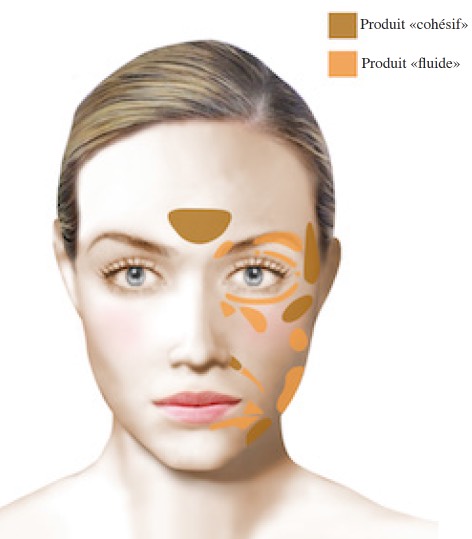With the growing demand for gentle and non-surgical techniques of Aesthetic Medicine aimed at fighting the effects of aging, the number and quality of injectable materials has considerably evolved in recent years and their use has become extremely frequent.
Hyaluronic Acid was discovered in 1934. It is a combination of a uronic acid and an aminoglycan.
The exceptional properties of this molecule made its use popular in many medical specialties, in particular in ophthalmology (cataract surgery), ENT (vocal cord surgery and urology mainly to help wound healing.
Since 1996, this molecule has been used and studied in the field of aesthetic filling.
Without tissue specificity and being endowed with exceptional viscoelastic and hydrophilic properties, this polysaccharide which does not require a test prior to treatment became the natural successor to injectable collagen in the treatment of wrinkles and hollows.
Hyaluronic acid is now considered the reference product used in medical volumetric rejuvenation for the following reasons:
- Its long standing existence. It's been used and proven to be efficient since the 90's.
- Its in situ duration varies from 8 to 24 months: the injections have a duration long enough to be effective and their transient nature makes it possible to track the aging process.
- Its lack of tissue specificity, makes it biocompatible and tolerance tests before injection are not necessary (except in specific areas).
- Its biodegradable property.
- Its ease of use; it does not require any preparation.
- Its extensive range of application: the same product can be transformed into different sub-variations to adapt to different types of aging.
- Its immediate results.
- Its minimal and very rare secondary effects.
The possibility to use hyaluronic acid in different sub-variations allows us to optimize its usage and make the most of its qualities:
- Moisturizing and revitalizing in mesotherapy
- Correction of superficial wrinkles
- Correction of deep wrinkles and volumes
An injection session can be performed on its own, but can also complement more radical medico-surgical rejuvenation procedures such as resurfacing (peeling, laser, dermabrasion, blepharoplasty (upper and/or lower eyelids), facelifts, etc. It can also be done in parallel with injections of Botulinum Toxin (Botox) aimed at reducing the tension in certain face muscles responsible for the appearance of wrinkles.
OBJECTIVES
An injection of hyaluronic acid is intended to correct, with a simple and rapid means, certain signs of aging on the face, by filling or giving volume where necessary.
The most frequent corrections can be divided into four categories:
Folds: nasolabial folds (from the wing of the nose to the corner of the mouth), folds from the corner of the mouth, on both sides of the chin, labio-mental furrow ...
Fine lines and wrinkles: forehead, "wrinkles of the lion" (between the eyebrows), "crow's feet" (at the corner of the eyes), cheeks, chin, "wrinkled sun" around the mouth.
Lips: redraw the hem (outline), thicken the lips if they are too thin or make them luscious.
Hollows or lack of volume: cheekbones, dark circles, chin, mandibular contour, cheeks, nose, temporal fossae, scarring (from acne, chickenpox, trauma…).

Hospitalization
Outpatient surgery
Anesthesia
Local
Duration
30 to 45 minutes
Bruising
Rare / 2 days
Result
Significant improvement visible at day 10, final appearance at 2 weeks after injection
Results lasting period
6 to 12 months


